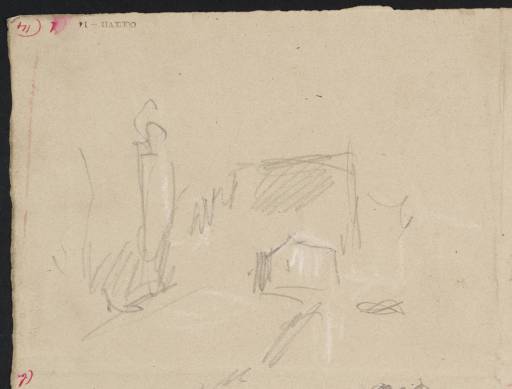Joseph Mallord William Turner A Campanile and nearby Buildings, Venice 1840
Joseph Mallord William Turner,
A Campanile and nearby Buildings, Venice
1840
Joseph Mallord William Turner 1775–1851
A Campanile and nearby Buildings, Venice 1840
D32199
Turner Bequest CCCXVII 14d
Turner Bequest CCCXVII 14d
Chalk and pencil on buff-grey wove paper, 230 x 301 mm
Inscribed in red ink ‘(d (14’ top left, upside down
Stamped in black ‘CCCXVII – 14’ top left upside down
Inscribed in red ink ‘(d (14’ top left, upside down
Stamped in black ‘CCCXVII – 14’ top left upside down
Accepted by the nation as part of the Turner Bequest 1856
References
1909
A.J. Finberg, A Complete Inventory of the Drawings of the Turner Bequest, London 1909, vol.II, p.1023, CCCXVII 14 (d), as part of ‘A piece of paper, ... folded into four. On back, – “3 V.” (d) A view’.
1930
A.J. Finberg, In Venice with Turner, London 1930, p.175, as ‘Do. Do. [i.e. ditto: A piece of paper ... folded into four, containing 4 slight sketches in pencil and white chalk]’, 1835 or 1840.
1999
Peter Bower, Turner’s Later Papers: A Study of the Manufacture, Selection and Use of his Drawing Papers 1820–1851, exhibition catalogue, Tate Gallery, London 1999, p.112 under no.66, as ‘CCCXVIII 14’.
2003
Ian Warrell in Warrell, David Laven, Jan Morris and others, Turner and Venice, exhibition catalogue, Tate Britain, London 2003, p.259.
This rapidly outlined, shaded and highlighted study is likely too slight to allow a particular identification, though it presumably shows a campanile and its adjacent church or other buildings. The three other sketches on this folded sheet (D32196–D34198; CCCXVII 14a, b, c; see the technical notes) include the Bridge of Sighs and the adjacent Palazzo Ducale (Doge’s Palace), so the present sketch may be of somewhere equally familiar if less iconic near the centre of the city.
Technical notes:
This is one of four slight subjects on the recto of a sheet folded vertically and horizontally; see also Tate D32196–D34198 (Turner Bequest CCCXVII 14a, b, c), and compare Tate D32192–D32195 (Turner Bequest CCCXVII 13a–d). The dimensions given are as recorded by Tate conservators, representing the overall sheet, and those of the present portion are approximately half those given in each direction.
Slight irregularities along the overall top edge of CCCXVII 13 (the half comprising D32192–D32193) match those at the bottom edge of the verso of CCCXVII 14 (D32198–D32199), showing that they once formed a continuous sheet. In discussing the papers used in Venice in 1840, Ian Warrell has described this as ‘Lightweight buff grey-paper from an unknown source, possibly English, with the watermark: “W”’.1
Among the Venetian sheets in paper conservator Peter Bower’s 1999 survey of Turner’s later papers,2 Tate D32233 (Turner Bequest CCCXVIII 14) was exhibited3 and reproduced, but there is a seemingly inadvertent mismatch.4 The detailed description and discussion of the sheet appear to apply to the present sheet, and Bower also refers to ‘CCCXVIII 13’,5 meaning CCCXVII 13. It is unclear whether the associated micrograph image relates to the present sheet or CCCXVIII 14.6 Bower noted: ‘Lightweight buff-grey wove | Watermark: W | Unknown maker’. He went on: ‘This quarter sheet is part of a well-formed lightweight buff wove sheet that also includes CCCXVIII 13’ (i.e. CCCXVII 13), torn down from a ‘full sheet size of approximately 17 ¾ x 22 ¾’ (inches; 450 x 578 mm), which ‘only matches one English paper size, Extra Large Post’, generally used for ‘white writing paper rather than coloured papers’; he suggested the German ‘Gross Median’ format of 460 x 590 mm as another possibility. Bower noted Tate D40202 (Turner Bequest LXXIV C), ‘erroneously catalogued as part of the [1802] Grenoble sketchbook’, but likely a Swiss 1840s sketch, as a ‘part sheet of this same paper ... also watermarked W in an outline capital’7 (compare the watermark on Tate D32195; Turner Bequest CCCXVII 13d).
Verso:
Blank; some brown staining at the edges.
Matthew Imms
September 2018
How to cite
Matthew Imms, ‘A Campanile and nearby Buildings, Venice 1840 by Joseph Mallord William Turner’, catalogue entry, September 2018, in David Blayney Brown (ed.), J.M.W. Turner: Sketchbooks, Drawings and Watercolours, Tate Research Publication, December 2019, https://www

